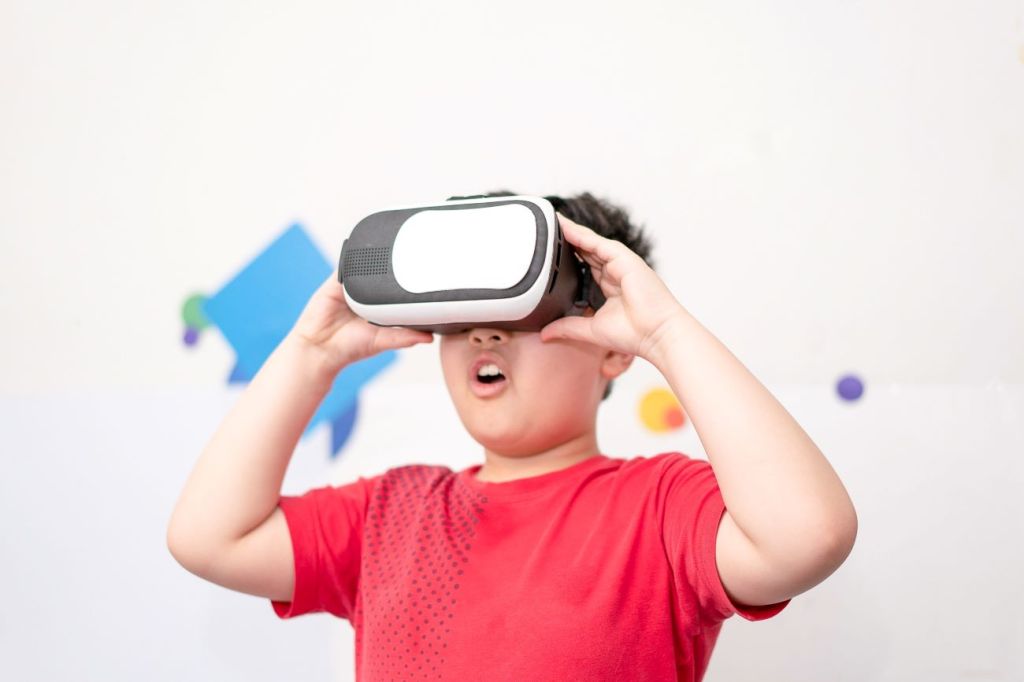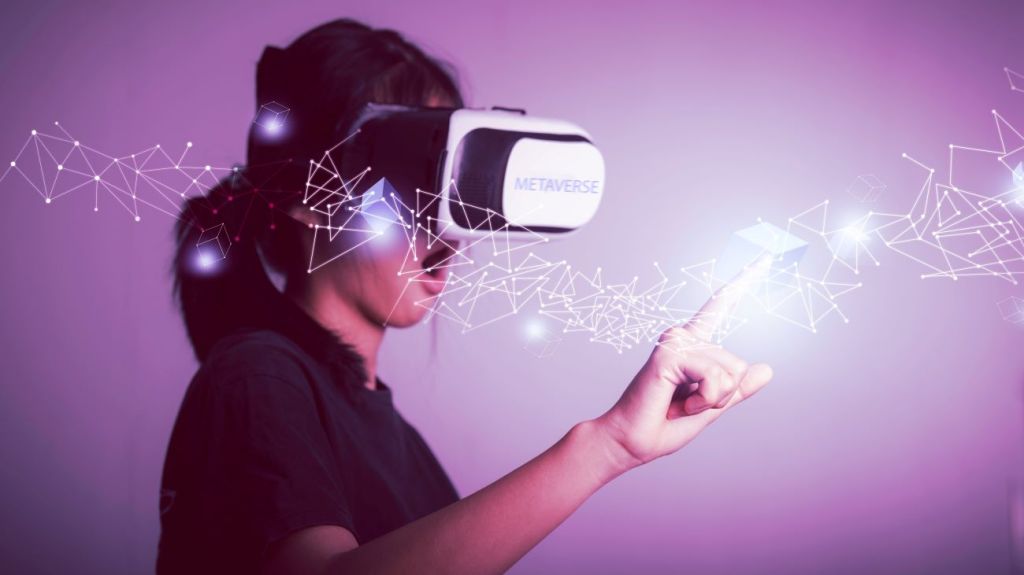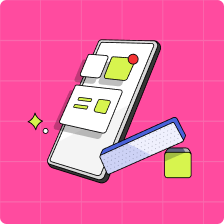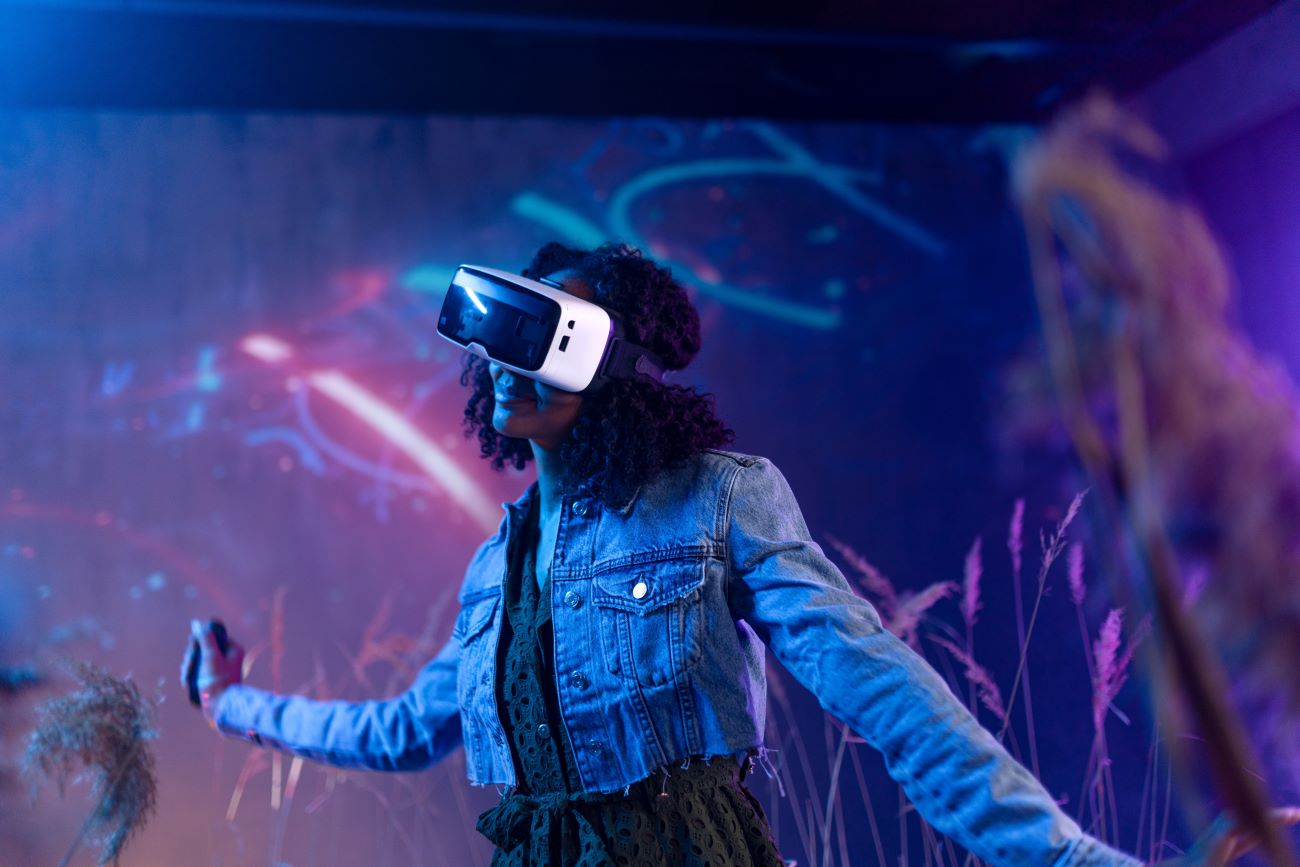Just when you thought you hit your stride in the universe we call home, the tech world has gone and upped the ante! Welcome to the metaverse—or, more accurately, the metaverses.
Like the multiple worlds in Spider-Man: Into the Spider-Verse, the metaverse isn’t a single, unified digital space, but a collection of spaces built on augmented reality (AR) and virtual reality (VR) technologies. Some of these metaverses can be seriously cool places for kids to connect and learn and socialize. Others? They’re not so cool.
As parents, your job is to understand how these spaces operate and to guide your kids in their use of them. So don’t stress, because even if you’re not caught up on the most cutting-edge aspects of AR or VR, you can still help make sure your kids have the best experience in the metaverse.
We help you decode what the metaverse is, explain how your kids might be spending their time there, cover the pros and cons of being a part of the metaverse, and share how much it all might cost. Let’s dig into what you need to know.
Key takeaways
- The metaverse isn’t a single place, but a collection of immersive online experiences that can (but don’t have to) involve aspects of virtual or augmented reality.
- Accessing most metaverse platforms is free, but in-app purchases and additional devices could cost some serious money.
- Some platforms, like Roblox, offer tools and monitoring to keep kids safe. Others offer minimal safeguards and may not be appropriate for kids under a certain age.
- Like with all online spaces, the metaverse poses potential risks in terms of bullying and mental health issues.
- The best strategy for parents is to be engaged and involved in what their child is doing in the metaverse, so they’re not navigating this new space alone.
What is the metaverse?
The metaverse is described as “an integrated network of 3D virtual worlds” where people can connect socially. You’ve probably figured out by now that the metaverse isn’t a specific place you can type into Google Maps and then find an address for it. To get there, all you need is a laptop or smartphone. Virtual reality headsets amplify and enhance the experience, but they’re not a requirement. And while the volume of media coverage about the metaverse makes it seem like the new thing, the word was first used in 1992 by sci-fi novelist Neal Stephenson in his book Snow Crash.
For Stephenson, the metaverse was the next step beyond the internet. In the book, it’s described as a giant, multiplayer game with avatars and virtual spaces to explore (and as an escape from a dystopian reality). Dystopian future aside, Stephenson’s concept for the metaverse was pretty spot-on.
Today’s metaverses, which can be considered in the early stages of the technology, exist virtually and are accessed via the internet. They’re home to everything from social hang out spaces to places to create, build, and play games.
The metaverse is also being explored as an educational tool, a wellness space, and even as a channel for medical professionals to treat patients.

What can kids do in the metaverse?
Metaverses come in a few different shapes and sizes. Some spaces, like Horizon Worlds from Meta (the company formerly known as Facebook), allow users to attend virtual events or hang out in virtual social settings. Others, like Roblox and Minecraft, are more centred on gaming, creating, and building things in virtual worlds.
The future of the metaverse, however, has the potential to be much, much bigger. It’s already possible to make purchases in the metaverse (think: games, outfits, and accessories for avatars, and even virtual real estate). In the near future, the metaverse is likely to become an arena where more and more companies purchase advertising space (imagine a virtual billboard), sell educational experiences, allow people to shop for and play digital instruments, and market virtual vacations.
For right now, it’s safe to assume that your kids are using the metaverse as a space to play games and socialize with their friends—ones they’ve both met online and know IRL.
Pros and cons of the metaverse
Like in every corner of the online world, there are pros and cons that come with accessing the metaverse. Helping your kids navigate these, as well as providing a balanced structure to their online and offline lives, is the best strategy to help them in having a positive experience with this type of tech.
Pros of the metaverse
The metaverse can act as a platform for your kid’s creativity and imagination, allowing them to design, build, and express themselves in a way that encourages them to learn about science, technology, engineering, and math (all that core STEM stuff that educators are encouraging kids to get into).
For older kids and teens especially, it also provides a space for hanging out, chatting, and building connections—something that’s been critically important during the pandemic and its related school closures.
Cons of the metaverse
The good news is that most of the cons about kids using the metaverse can be mitigated by engaged and involved parenting. Metaverse platforms like Roblox and Minecraft are equipped with parental controls that safeguard kids from things like privacy violations or inappropriate content. They can also prevent purchases from being made on a credit card belonging to someone else (ahem: you).
Another element to be aware of: Despite the metaverse being a virtual or augmented reality space, real-world injuries can and do happen. Just like kids can get carsick or airsick, they can also get cybersick from eye strain, nausea, and poor-fitting headsets designed for larger adult skulls. And with headsets on, there’s the whole “running-into- an-IRL-coffee-table-and/or-sibling-who-doesn’t-show-up-in-the-metaverse” thing. Ouch!
How much does the metaverse cost?
Technically, you can access the metaverse for free as long as you have a device that will take you there and an internet connection. Once you arrive, however, there are plenty of opportunities to spend that money (insert dollar sign eyes emoji here). The most immersive experiences require VR headsets, which can range from several hundred dollars for high-end sets, like the Oculus Quest 2, to under $20 for Google Cardboard, which works with your Android device or iPhone. And inside metaverses like Roblox or Minecraft, it’s possible to make purchases (Roblox even has its own currency, Robux) in terms of games, in-game add-on purchases, or private spaces to hang out and play games with friends.
Both non-fungible tokens (NFTs) and cryptocurrencies are a part of the metaverse landscape, too. Here’s an example: Metaverse platform The Sandbox (a project backed by Atari) launched its own token, SAND, that players can use to buy and sell NFTs inside this particular metaverse. One of the platform’s popular projects is a collab with the makers of the comic book-based movie Hellboy. They’ve also teamed up with brands like Adidas and Gucci, and created NFTs with Snoop Dogg and The Smurfs. The Sandbox’s Care Bear collection features 3D digital bear gaming characters that sell for between approximately US$20 and US$352 (which is $262.50 in SAND currency)!
Tl;dr (that’s “too long; didn’t read”)? Let’s just say that you (and your kids) can definitely rack up some debt in the metaverse if you aren’t careful in communicating with them that virtual items can cost real money.
There’s another side to that equation, though. If your kids are interested in the creating and building aspect of whatever metaverse they’re into, there’s an opportunity for them to sell their digital creations on platforms that facilitate those types of transactions (like The Sandbox).
Yes, kids can spend money in the metaverse, but there is also the potential for talented kids to make money there, too.

Is the metaverse safe for kids?
There are risks involved with kids spending time in the metaverse. Some parts of the metaverse (like Second Life) are designed as adults-only spaces, while others lack standardized parental controls to safeguard underage users. The safest platforms will allow parents to turn off the chat function, or only allow messages to be accepted from an approved list of known contacts.
Certain metaverse platforms feature sexual content that is inappropriate for children, while others are places where kids could be subjected to harassment, or taken advantage of by scammers. The best strategy for keeping kids safe is to be aware of the platforms and games they’re engaging with—which doesn’t necessarily mean policing the content they consume. Instead, make it a topic of conversation, or play alongside them on a regular basis. Warning: You might like it.
What age is the metaverse appropriate for?
It depends on the platform. Some major brands, like Facebook’s Oculus VR portal and devices, state they’re not for kids under 13, but there’s little to stop younger kids from accessing the space. If they can access a Facebook account, then they can use Oculus and the metaverse app, Horizon.
On the other end of the safety spectrum is Roblox, a company that not only equips their metaverse platforms and applications with a menu of parental control options, but also engages in thorough monitoring for any behaviour or content that violates its terms of use. Roblox is recommended for kids aged 10 and up and divides users into two categories: under 13 and over 13, with stricter safety measures for the under 13 demographic. Helping your kids set up their account will ensure they enter their correct birth year and are filtered into the right age group.
The metaverse’s effect on mental health and youth
The metaverse is a new-ish thing, and its effects on mental health could potentially extend beyond some of the tech-related health issues we’re already familiar with.
Cyberbullying occurs across almost every online channel, from YouTube to TikTok, and the metaverse is no exception. Bullying can come both from people your kids know, as well as complete strangers, or people they only “know” online. While the ability to socialize online can be a positive feature about the metaverse, it isn’t without the risk of your child encountering an online bully.
Beyond cyberbullying, one of the key concerns about the immersive experiences offered by the metaverse is that children’s brains might be less able to respond critically to an AR or VR environment. Translation: Their experiences could become more tangled up with their real lives, especially if those experiences are ones that trigger emotional responses. Be aware of the way your child reacts to these platforms. And remember: Taking breaks is always a healthy option.

Tips for keeping your kids safe in the metaverse
Ready to explore the metaverse with your kids? Here are some pointers on how to make sure the adventure is safe and fun:
- Set limits on time spent playing games in the metaverse in the same way you would set limits on other devices, like phones and gaming consoles.
- Set up metaverse accounts with your child to make sure they’re providing the correct age details required to access certain platforms.
- Make use of parental controls that allow you to limit your child’s interactions with strangers and filter violent or sexual content.
- Talk to your child about the importance of keeping personal data secure and private—even small details they may not realize the importance of, like their birthdate.
- Explore the metaverse with your child, so you understand how they’re spending their time online—get them to show you their favourite games. Just think: It could become a thing you enjoy together!
The metaverse and the related technological advances that are sure to come with it can be educational, stimulating, creative, and fun places for kids to spend time in (and might even inspire a future career in tech, design, or a related field). There are so many possibilities for kids in these virtual worlds. With the right guidance and support from parents (and with a boost from Mydoh), kids can thrive IRL and online.
Download Mydoh and help build the foundation of financial literacy for your kids and teenagers.
This article offers general information only and is not intended as legal, financial or other professional advice. A professional advisor should be consulted regarding your specific situation. While the information presented is believed to be factual and current, its accuracy is not guaranteed and it should not be regarded as a complete analysis of the subjects discussed. All expressions of opinion reflect the judgment of the author(s) as of the date of publication and are subject to change. No endorsement of any third parties or their advice, opinions, information, products or services is expressly given or implied by Royal Bank of Canada or its affiliates.








